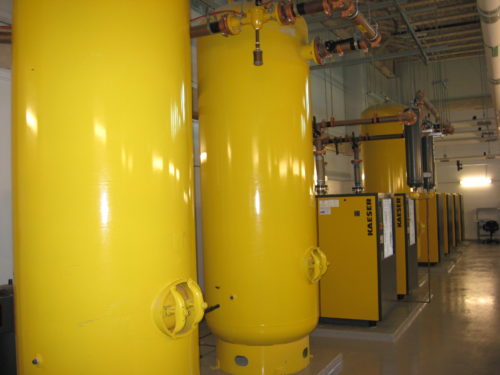Five Key Advantages of Compressed Air Energy Storage
Compressed air energy storage (CAES) provides a way to store compressed air inside a sealed space. By utilizing a compressed air system, users can supplement their energy needs during peak demand times, which improves air quality and ensures system stability. The energy is recovered by allowing the air to expand through a turbine. The heat released during this expansion can be reused to boost energy efficiency.
What Is Compressed Air Energy Storage?
 Compressed air energy storage is used for large-scale energy storage, where the air is kept under pressure in storage tanks or underground caverns. The air is pressurized using a compressor and stored until the energy is required. When needed, the stored energy is retrieved by allowing the air to expand, driving high-pressure air through a turbine to generate electricity.
Compressed air energy storage is used for large-scale energy storage, where the air is kept under pressure in storage tanks or underground caverns. The air is pressurized using a compressor and stored until the energy is required. When needed, the stored energy is retrieved by allowing the air to expand, driving high-pressure air through a turbine to generate electricity.
As the expanding air cools significantly, it must be reheated before passing through the turbine. This can be done using either diabatic or adiabatic methods:Â
- In the diabatic method, fuel is used to heat the air before it enters the turbine.Â
- The adiabatic technique captures heat generated during the initial compression phase and applies that heat during expansion, thus raising the air temperature without consuming additional energy.Â
While the adiabatic approach is more energy-efficient and emission-free, it requires advanced thermal storage technologies that aren't widely available yet. Researchers are actively exploring various isothermal CAES methods to make the heating and cooling processes more energy-efficient.
Benefits of Compressed Air Energy Storage
CAES presents a wide array of advantages across different applications. The five primary benefits of CAES include cost savings, improved air quality, enhanced system stability, reduced maintenance expenses, and extended compressor lifespan.
Cost Efficiency
CAES is employed to store energy for peak demand periods, thereby decreasing the stress on the electrical grid. This enables utility providers to supply adequate energy without needing extra generation during peak hours. On a smaller scale, CAES can cut reliance on the grid, lowering energy bills and operational costs. Additionally, by storing pressurized air, CAES eliminates the need for a separate compressor entirely.
Better Air Quality
Compared to other energy production methods, CAES emits far fewer CO2 gases. Utilizing adiabatic processes can virtually eliminate emissions. Combined with decreased dependence on fossil-fuel-based grids, CAES offers an environmentally friendly energy option.
System Stability
Using CAES as a supplementary energy source strengthens power grid resilience during peak times or sudden spikes in electricity usage. This eases the burden on the electrical infrastructure while improving reliability and reducing emissions. For smaller setups, compressed air energy storage ensures more dependable and consistent electrical output.
Maintenance Savings
CAES systems demand minimal upkeep compared to traditional energy production methods. In smaller-scale operations, compressed air storage reduces the frequency of compressor maintenance, cutting down on repair costs.
Longer Equipment Lifespan
Because CAES systems store compressed air, the compressor doesn't have to run constantly. This decreases wear and tear on the compressor, extending its operational life. Storing compressed air also allows the compressor to fully unload before restarting, preventing frequent starts and stops that could damage the equipment. Simplifying the control strategy for CAES systems can be achieved by sequencing multiple compressors.
More Insights Into Compressed Air Energy Storage
A Brief History of Compressed Air Energy Storage
CAES was first introduced at a facility in Huntorf, Germany, in 1978. Still operational today, the plant has a capacity of 290 MW. The compressed air is stored underground in abandoned salt mines and used to support the energy grid during peak demand. The only other major CAES plant worldwide was built in 1991 in McIntosh, Alabama. This system also uses underground salt caverns for air storage and has a capacity of 110 MW.
Even though excavated salt mining caverns aren’t accessible everywhere, recent studies suggest that certain types of porous and permeable rocks might serve the same purpose. Scientists aim to expand the role of CAES from just load-shifting to becoming a significant source of clean energy production. Engineers are also developing technology to extend the application of CAES to small-scale, off-grid operations.
How Compressed Air Energy Storage Works
The CAES process is straightforward but requires specialized equipment. Electricity from the main grid or renewable sources powers a compressor that pumps air into a storage container. For large-scale storage, the pressurized air is kept in underground caverns, whereas small-scale operations might use specialized storage tanks. When electricity is needed, the compressed air is released from the holding tank and heated using either stored heat from the compression phase or heat generated by burning fossil fuels. The expanding air moves through a turbine to generate electricity.
The energy potential of the compressed air depends on its density. Therefore, the storage cavern or tank must withstand immense pressure and density. Typically, strong and durable carbon fiber is used in small-scale CAES systems to store compressed air safely.
Compressed Air Energy Storage Solutions From Compressed Air Systems
At Compressed Air Systems, we provide a variety of air compressors and storage solutions tailored to your operational requirements. Properly sized compressed air storage tanks can offer affordable energy production without needing to run another compressor. To discover more about our CAES offerings, contact us today.

Handheld Mixer,Immersion Blender,Egg Blender,Wireless Mixer
Guangdong Shunde Zhenheng Plastic Co., Ltd, China. , https://www.ga-well.com